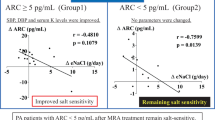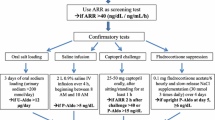Abstract
For many years, primary aldosteronism was thought (and taught) to be a relatively rare (<1 %) and benign form of high blood pressure: now we know that neither is the case. Currently, the prevalence is considered to be 5–10 % of hypertensives, on the basis of more or less stringent cutoffs for the aldosterone/renin ratio and plasma aldosterone concentration: increasingly, evidence is mounting that the true prevalence of (relatively) autonomous aldosterone secretion may be ∼30 % of hypertensives. There is, in addition, a consensus that the risk profile for patients with primary aldosteronism is substantially higher than in age-, sex-, and blood pressure-matched essential hypertensives; the cardiovascular/renal damage in primary aldosteronism is thus not a primary effect of raised blood pressure. The nexus between salt and primary aldosteronism is clear, as equivalently raised or even higher levels of plasma aldosterone in chronic sodium deficiency are homeostatic and do not cause cardiovascular damage, thus ruling out deleterious effects of aldosterone acting alone. In primary aldosteronism the normal homeostatic feedback loops between sodium status and aldosterone levels are disturbed, so that cardiovascular/renal damage reflects inappropriate aldosterone levels for sodium status. One possible actor in such a scenario is endogenous ouabain (or similar compounds), which is elevated in the sodium-loaded state and a vasoconstrictor, and thus potentially be able both to raise blood pressure and to cause cardiovascular/renal damage. A second consideration is that of the epidemiologic data linking a chronically high salt intake to a raised blood pressure. If autonomous aldosterone secretion is in fact present in ∼30 % of hypertensives, this may be the group sensitive to the pressor effects of high salt, with the remainder much less affected. Finally, at a practical level given even the currently accepted prevalence of primary aldosteronism, a radical reconsideration of first-line antihypertensive therapy is proposed.
Similar content being viewed by others
References
Ahmed AH, Cowley D, Wolley M, Gordon RD, Xu S, Taylor PJ, Stowasser M (2014) Seated saline suppression testing for the diagnosis of primary aldosteronism: a preliminary study. J Clin Endocrinol Metab 99(8):2745–2753. doi:10.1210/jc.2014-1153
Amar L, Azizi M, Menard J, Peyrard S, Plouin PF (2013) Sequential comparison of aldosterone synthase inhibition and mineralocorticoid blockade in patients with primary aldosteronism. J Hypertens 31(3):624–629. doi:10.1097/HJH.0b013e32835d6d49, discussion 629
Arriza JL, Weinberger C, Cerelli G, Glaser TM, Handelin BL, Housman DE, Evans RM (1987) Cloning of human mineralocorticoid receptor complementary DNA: structural and functional kinship with the glucocorticoid receptor. Science 237(4812):268–275
Asayama K, Stolarz-Skrzypek K, Persu A, Staessen JA (2014) Systematic review of health outcomes in relation to salt intake highlights the widening divide between guidelines and the evidence. Am J Hypertens 27(9):1138–1142. doi:10.1093/ajh/hpu126
Brilla CG, Weber KT (1992) Mineralocorticoid excess, dietary sodium, and myocardial fibrosis. J Lab Clin Med 120(6):893–901
Conn JW (1955) Primary Aldosteronism, a new clinical syndrome. J Lab Med 45(1):3–17
Dostanic-Larson I, Van Huysse JW, Lorenz JN, Lingrel JB (2005) The highly conserved cardiac glycoside binding site of Na, K-ATPase plays a role in blood pressure regulation. Proc Natl Acad Sci U S A 102(44):15845–15850
Edwards CR, Stewart PM, Burt D, Brett L, McIntyre MA, Sutanto WS, de Kloet ER, Monder C (1988) Localisation of 11 beta-hydroxysteroid dehydrogenase—tissue specific protector of the mineralocorticoid receptor. Lancet 2(8618):986–989
Ekinci EI, Clarke S, Thomas MC, Moran JL, Cheong K, MacIsaac RJ, Jerums G (2011) Dietary salt intake and mortality in patients with type 2 diabetes. Diabetes Care 34(3):703–709. doi:10.2337/dc10-1723
Funder JW (2012) Primary aldosteronism: are we missing the wood for the trees? Horm Metab Res 44(3):251–253. doi:10.1055/s-0031-1301281
Funder JW (2013) Mineralocorticoid receptor antagonists: emerging roles in cardiovascular medicine. Integr Blood Press Control 6:129–138. doi:10.2147/IBPC.S13783, Review
Funder JW (2014) Sensitivity to aldosterone: plasma levels are not the full story. Hypertension 63(6):1168–1170. doi:10.1161/HYPERTENSIONAHA.114.03127
Funder JW, Carey RM, Fardella C et al (2008) Case detection, diagnosis, and treatment of patients with primary aldosteronism: an Endocrine Society Clinical Practice Guideline. J Clin Endocrinol Metab 93:3266–3281. doi:10.1210/jc.2008-0104
Funder JW, Feldman D, Edelman IS (1973) The roles of plasma binding and receptor specificity in the mineralocorticoid action of aldosterone. Endocrinology 92(4):994–1004
Funder JW, Pearce PT, Smith R, Smith AI (1988) Mineralocorticoid action: target tissue specificity is enzyme, not receptor, mediated. Science 242(4878):583–585
Gómez-Sánchez EP, Venkataraman MT, Thwaites D, Fort C (1990) ICV infusion of corticosterone antagonizes ICV-aldosterone hypertension. Am J Physiol 258(4 Pt 1):E649–E653
Gouli A, Kaltsas G, Tzonou A et al (2011) High prevalence of autonomous aldosterone secretion among patients with essential hypertension. Eur J Clin Investig 41(11):1127–1136. doi:10.1111/j.1365-2362.2011.02531.x
Hannemann A, Wallaschofski H (2012) Prevalence of primary aldosteronism in patient’s cohorts and in population-based studies—a review of the current literature. Horm Metab Res 44:157–162. doi:10.1055/s-0031-1295438
Hasegawa T, Masugi F, Ogihara T, Kumahara Y (1987) Increase in plasma ouabainlike inhibitor of Na+, K+−ATPase with high sodium intake in patients with essential hypertension. J Clin Hypertens 3(4):419–429
He FJ, Li J, Macgregor GA (2013) Effect of longer-term modest salt reduction on blood pressure. Cochrane Database Syst Rev 4:CD004937. doi:10.1002/14651858.CD004937.pub2, Review
Helber A, Wambach G, Hummerich W, Bšnner G, Meurer KA, Kaufmann W (1980) Evidence for a subgroup of essential hypertensives with non-suppressible excretion of aldosterone during sodium loading. Klin Wochenschr 58(9):439–447, No abstract available
Hiramatsu K, Yamada T, Yukimura Y, Komiya I, Ichikawa K, Ishihara M, Nagata H, Izumiyana T (1981) A screening test to identify aldosterone-producing adenoma by measuring plasma renin activity: results in hypertensive patients. Arch Intern Med 141:1589–1593
Ito Y, Takeda R, Karashima S, Yamamoto Y, Yoneda T, Takeda Y (2011) Prevalence of primary aldosteronism among prehypertensive and stage 1 hypertensive subjects. Hypertens Res 34(1):98–102. doi:10.1038/hr.2010.166
Kagawa CMBD (1964) Relationship of plasma aldadiene levels and antimineralocorticoid effects of spironolactone in the laboratory. Proc Soc Exp Biol Med 115:837–840
Kaplan NM (2012) Primary aldosteronism: evidence against a second epidemic. J Hypertens 30(10):1899–1902. doi:10.1097/HJH.0b013e3283559a03
Kassahn KS, Ragan MA, Funder JW (2011) Mineralocorticoid receptors: evolutionary and pathophysiological considerations. Endocrinology 152(5):1883–1890. doi:10.1210/en.2010-1444
Kempers MJ, Lenders JW, van Outhousden L, van der Wilt GJ, Schultze Kool LJ, Hermus KR, Deinum J (2009) Systematic review: diagnostic procedures to differentiate unilateral from bilateral adrenal abnormality in primary aldosteronism. Ann Intern Med 151(5):329–337, Review
Krozowski ZS, Funder JW (1983) Renal mineralocorticoid receptors and hippocampal corticosterone-binding species have identical intrinsic steroid specificity. Proc Natl Acad Sci U S A 80(19):6056–6060
Kÿpers EM, Amar L, Raynaud A, Plouin PF, Steichen O (2012) A clinical prediction score to diagnose unilateral primary aldosteronism. J Clin Endocrinol Metab 97(10):3530–3537. doi:10.1210/jc.2012-1917
Laredo J, Shah JR, Lu ZR, Hamilton BP, Hamlyn JM (1997) Angiotensin II stimulates secretion of endogenous ouabain from bovine adrenocortical cells via angiotensin type 2 receptors. Hypertension 29(1 Pt 2):401–407
Le Loan TY, Mardini M, Howell VM, Funder JW, Ashton AW, Mihailidou AS (2012) Low-dose spironolactone prevents apoptosis repressor with caspase recruitment domain degradation during myocardial infarction. Hypertension 59(6):1164–1169. doi:10.1161/HYPERTENSIONAHA.111.190488
Levy D, Rocha R, Funder JW (2004) Distinguishing the antihypertensive and electrolyte effects of eplerenone. J Clin Endocrinol Metab 89:2736–2740
Mangelsdorf DJ, Thummel C, Beato M, Herrlich P, SchŸtz G, Umesono K, Blumberg B, Kastner P, Mark M, Chambon P, Evans RM (1995) The nuclear receptor superfamily: the second decade. Cell 83(6):835–839
Mihailidou AS, Le TYL, Mardini M, Funder JW (2009) Glucocorticoids activate cardiac mineralocorticoid receptors during experimental myocardial infarction. Hypertension 54(6):1306–1312. doi:10.1161/HYPERTENSIONAHA.109.136242
Milliez P, Girerd X, Plouin PF, Blacher J, Safar ME, Mourad JJ (2005) Evidence for an increased rate of cardiovascular events in patients with primary aldosteronism. J Am Coll Cardiol 45(8):1243–1248
Nishikawa T, Omura M, Satoh F, Shibata H, Takahashi K, Tamura N, Tanabe A (2011) Task force committee on primary Aldosteronism, the Japan endocrine society. Guidelines for the diagnosis and treatment of primary aldosteronism—the Japan Endocrine Society 2009. Endocr J 58(9):711–721
Nishizaka MK, Zaman MA, Calhoun DA (2003) Efficacy of low-dose spironolactone in subjects with resistant hypertension. Am J Hypertens 16(11 Pt 1):925–930
Ori Y, Chagnac A, Korzets A, Zingerman B, Herman-Edelstein M, Bergman M, Gafter U, Salman H (2013) Regression of left ventricular hypertrophy in patients with primary aldosteronism/low-renin hypertension on low-dose spironolactone. Nephrol Dial Transplant 28(7):1787–1793. doi:10.1093/ndt/gfs587
Pitt B, Kober L, Ponikowski P, Gheorghiade M, Filippatos G, Krum H, Nowack C, Kolkhof P, Kim SY, Zannad F (2013) Safety and tolerability of the novel non-steroidal mineralocorticoid receptor antagonist BAY 94–8862 in patients with chronic heart failure and mild or moderate chronic kidney disease: a randomized, double-blind trial. Eur Heart J 34(31):2453–2463. doi:10.1093/eurheartj/eht187
Pollan M (2013) Cooked: a natural history of transformation. Penguin, New York
Qin W, Rudolph AE, Bond BR, Rocha R, Blomme EA, Goellner JJ, Funder JW, McMahon EG (2003) Transgenic model of aldosterone-driven cardiac hypertrophy and heart failure. Circ Res 93(1):69–76
Rickard AJ, Morgan J, Tesch G, Funder JW, Fuller PJ, Young MJ (2009) Deletion of mineralocorticoid receptors from macrophages protects against deoxycorticosterone/salt-induced cardiac fibrosis and increased blood pressure. Hypertension 54(3):537–543. doi:10.1161/HYPERTENSIONAHA.109.131110
Riester A, Fischer E, Degenhart C, Reiser MF, Bidlingmaier M, Beuschlein F, Reincke M, Quinkler M (2014) Age below 40 or a recently proposed clinical prediction score cannot bypass adrenal venous sampling in primary aldosteronism. J Clin Endocrinol Metab 99(6):E1035–E1039. doi:10.1210/jc.2013-3789
Rossi GP, Bernini G, Caliumi C, Desideri G, Fabris B, Ferri C et al (2006) A prospective study of the prevalence of primary aldosteronism in 1125 hypertensive patients. J Am Coll Cardiol 48:2293–2300
Savard S, Amar L, Plouin PF, Steichen O (2013) Cardiovascular complications associated with primary aldosteronism: a controlled cross-sectional study. Hypertension 62(2):331–336. doi:10.1161/HYPERTENSIONAHA.113.01060
Simpson SA, Tait JF, Wettstein A, Neher R, Von Euw J, Reichstein T (1953) Isolierung eines neuen kristallisierten Hormons aus Nebennerien mit besonders hoher Wirksamkeit auf din Mineralsoffwechsel. Experientia 9(9):333–335
Stowasser M, Sharman J, Leano R, Gordon RD, Ward G, Cowley D, Marwick TH (2005) Evidence for abnormal left ventricular structure and function in normotensive individuals with familial hyperaldosteronism type I. J Clin Endocrinol Metab 90(9):5070–5076
Tu W, Eckert GJ, Hannon TS, Liu H, Pratt LM, Wagner MA, Dimeglio LA, Jung J, Pratt JH (2014) Racial differences in sensitivity of blood pressure to aldosterone. Hypertension 63(6):1212–1218. doi:10.1161/HYPERTENSIONAHA.113.02989
Young M, Funder JW (2004) Eplerenone, but not steroid withdrawal, reverses cardiac fibrosis in deoxycorticosterone/salt-treated rats. Endocrinology 145(7):3153–3157
Author information
Authors and Affiliations
Corresponding author
Additional information
This article is published as part of the Special Issue on Salt.
Rights and permissions
About this article
Cite this article
Funder, J.W. Primary aldosteronism and salt. Pflugers Arch - Eur J Physiol 467, 587–594 (2015). https://doi.org/10.1007/s00424-014-1658-0
Received:
Revised:
Accepted:
Published:
Issue Date:
DOI: https://doi.org/10.1007/s00424-014-1658-0




